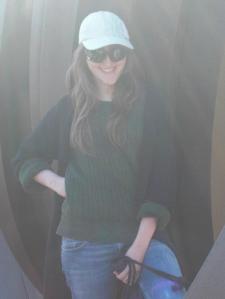When answering questions with different categories of people (or sets of numbers), it is best to draw a Venn diagram!
Let's start off by drawing a rectangle. The rectangle represents everyone from the survey. Everything inside the rectangle should add up to 200.
Now we'll draw two circles overlapping. Label one circle "DVD" and the other circle maybe "M" for microwave oven. The whole DVD circle (including the overlap) is set A. The whole M circle is set B (including the overlap). The overlap area is A intersection B (A upside down U B). The part of the DVD circle that is not part of the overlap is known as A intersection B^c (because it includes anyone from A that is NOT from set b). The part of the of the M circle that is not part of the overlap is known as B intersection A^c ( because it includes anyone from B that is NOT from set A).
The two circles should overlap in the middle. It is best to start with the people that belong to BOTH categories. In the overlap area, we should put 72 because 72 people owned both. (in other words, A intersection B = 72)
Now, the entire circle labeled DVD should add up to 96 (set A = 96), but this includes the 72 people in the middle! So we should subtract out the 72 people in the middle from the 96 to find the people who only owned a DVD player. (96-72 = 24). We can put "24" in the blank part of the circle labeled DVD. The blank part of the circle (not including the overlap) represents A intersection B^c.
Now, the entire circled labeled "M" should add up to 129, but this also includes the 72 people in the middle who owned both! Again, we should subtract out the people 72 people from the 129. (129 - 72 = 57). The 57 goes in the blank part of the circle labeled "M". This represents B intersection A^c
So far, it should look something like this:
A intersection B^c A intersection B B intersection A^c
DVD (both) M
24 72 57
So far, we should be curious "How many people is that so far? Have I accounted for all 200 people?" If you add up 24 + 72 + 57 to check, that's definitely not 200 (all of the people in the survey)! So where did the other 153 people go? Those must be the people that owned neither a DVD or a microwave oven. They would go outside of the circles, but in the rectangle. ***CORRECTION: We forgot to subtract the 153 from the 200 ---> 200 - 153 = 47.**
47
A intersection B^c A intersection B B intersection A^c
DVD Overlap of both M
24 72 57
Now we can answer the questions.
(a) A DVD or a microwave oven.
Keep in mind that the key word here is "or". We do not want the people who own both a DVD and microwave oven. Just the people that own either one. Thus, we should add 24 + 57. (In set notation, this would be ((A U B) - (A intersection B)).
Answer: 81
(b) A DVD but not a microwave oven.
In set notation, this is A intersection B^c. In simple terms, the part of the DVD circle that doesn't have any overlap.
Answer: 24
(c) a microwave not a DVD
In set notation, this is B intersection A^c. In simple terms, the part of the microwave circle that doesn't have any overlap.
Answer: 57
(d) Neither a DVD nor a microwave oven.
In set notation, this is (A U B)' (meaning everything that is not part of both A and B). In simple terms, outside the circles, but inside the rectangle.
*CORRECTED Answer: 47*

Leah A.
05/24/19





Alice T.
I also got 81 and 153 and both are incorrect.05/24/19